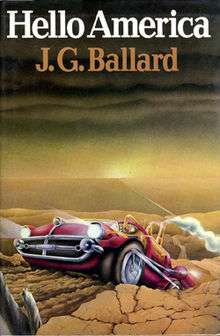Hello America
 Cover of first edition (hardcover) | |
| Author | J. G. Ballard |
|---|---|
| Country | United Kingdom |
| Language | English |
| Genre | Science fiction novel |
| Publisher | Jonathan Cape |
Publication date | June 4, 1981 |
| Media type | Print (Hardcover & Paperback) |
| Pages | 224 pp |
| ISBN | 0-224-01914-7 |
| OCLC | 9325708 |
| 823/.914 19 | |
| LC Class | PR6052.A46 H4 1981 |
Hello America is a science fiction novel by J. G. Ballard, first published in 1981. The plot follows an expedition to a North America rendered uninhabitable by an ecological disaster.
Plot summary
Ballard's 9th novel is set in the year 2114 AD, several generations after an ecological collapse has rendered North America virtually unlivable. Most of the population was evacuated to Europe and Asia. The bulk of the novel takes place when a European steamship, the SS Apollo, sails to America to try to discover the cause of increased radioactive fallout in England.
In typical Ballardian fashion, each of the crew members has a secret agenda, and is basically a pawn of their own psychological yearnings, whether for destruction or glory. Most of the Apollo's crew are descended from expatriate Americans - the protagonist is a young man who grew up in the American Ghetto in Dublin, for instance - and have become mostly assimilated into European society, but still feel some vague draw to the abandoned continent to the west.
In the novel, the Soviet Union dammed the Bering Strait in the 1990s, thus changing global weather patterns by reversing the normally clockwise currents in the Pacific Ocean. Although the Russians were able to grow grain as far north as the Arctic Circle, a massive drought began east of the Rocky Mountains. West of the Rockies, the opposite problem was true. Further, much of coastal Asia freezes over.
Though the plot is a straightforward adventure yarn—quite unusual for Ballard—the book is actually a subtle parody of American culture. For instance, the final President of the United States was the then-current governor Jerry Brown of California, who was a promising face in American politics at the time of the novel. His small, ironic role in the novel represents both the triumph and ultimate failure of west coast liberalism of the late Cold War era: when faced with a massive ecological crisis that threatens (and indeed ultimately destroys) the nation, Brown's solution is to build a large youth center, a twice-life-size fiberglass replica of the Taj Mahal, and then abandons the country so he can devote himself to self-improvement. The novel states that Brown dies at age 114 in a Buddhist Monastery in a glaciated Japan.
Eventually the Apollo Expedition comes across survivors from the previous expedition thirty years earlier. One of these survivors—clearly insane—has taken to calling himself "President Charles Manson," but none of the Apollo's crew get the reference because the Manson killings occurred 120 years earlier in a completely different world.
In the end, it is implied that Europe needs America, if only as a place where the darker elements of the Western mindset can be allowed to play themselves out without inconveniencing decent people. There is a kind of rebirth that re-establishes something akin to the old order, allowing insanity to be sublimated out in small doses to everyone, rather than bottled up in one person where it proves to be really really dangerous. Possibly for the first time ever, nuclear weapons are used for a constructive purpose, and the 'New World Order' that arises from the events of the book contains both the promise of a better future, and the understated vague promise/threat of phantasmagoric horrors to come, though presumably in smaller doses.
Criticism
- Rossi, Umberto (1994). "Images from the Disaster Area: An Apocalyptic Reading of Urban Landscapes in Ballard's The Drowned World and Hello America", Science-Fiction Studies #62, 21:1, March, 81-97.
- Pringle, David. News From The Sun #9, October 1983. Pringle notes that Hello America is effectively a tribute to Limbo (1952) by Bernard Wolfe, and that Ballard has acknowledged the parallels between the two books.